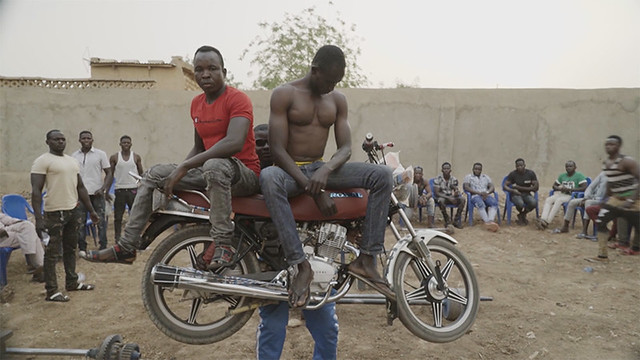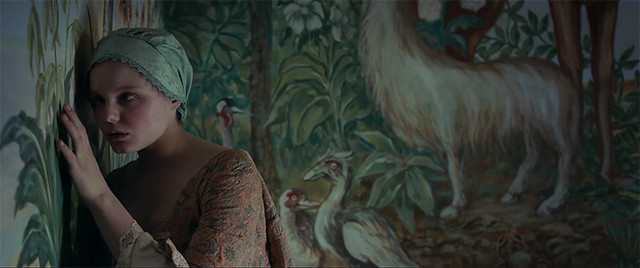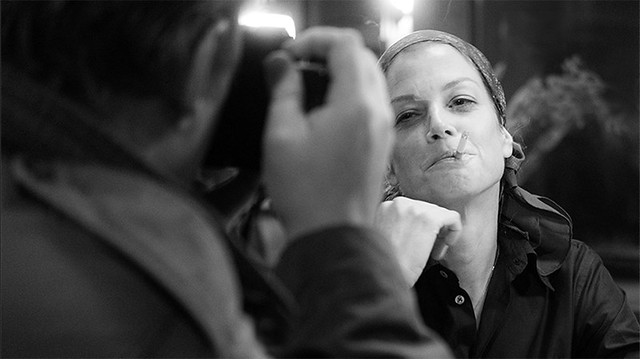Below are some of the most intriguing titles I was able to sample:
Bonjour Tristesse - Durga Chew-Bose
 The original 1958 version, a cautious coming-of-age tale directed by Otto Preminger, made a star out of pixie-cut Jean Seberg (later to be immortalized in Godard's Breathless). It seemed Bonjour Tristesse was primed for an update. Durga Chew-Bose, a Canadian filmmaker, makes it her feature debut with Claes Bang as Raymond, a widowed father, Chloe Sevigny as Anne, Raymond's old friend, an elegant fashion designer from Paris and Lily McInerny as Cécile, a wide-eyed seventeen-year-old, trying to fix up her father's love life. In Chew-Bose's hand, this sun-drenched, French Riviera set fairy-tale-gone-wrong plays out like an elegant chamber piece, beautifully shot by Maximilian Pittner. She concentrates on the tender father-daughter relationship with a hint of sadness.
The original 1958 version, a cautious coming-of-age tale directed by Otto Preminger, made a star out of pixie-cut Jean Seberg (later to be immortalized in Godard's Breathless). It seemed Bonjour Tristesse was primed for an update. Durga Chew-Bose, a Canadian filmmaker, makes it her feature debut with Claes Bang as Raymond, a widowed father, Chloe Sevigny as Anne, Raymond's old friend, an elegant fashion designer from Paris and Lily McInerny as Cécile, a wide-eyed seventeen-year-old, trying to fix up her father's love life. In Chew-Bose's hand, this sun-drenched, French Riviera set fairy-tale-gone-wrong plays out like an elegant chamber piece, beautifully shot by Maximilian Pittner. She concentrates on the tender father-daughter relationship with a hint of sadness.
Sevigny, playing against type as an uptight, motherly Anne, with an air of unapproachability, a wounded woman being denied of her long-lost love for the second time. With decidedly old fashioned - costumes, the old parent-trap theme, Bonjour Tristesse doesn't feel like it belongs in 2025, but this reboot is fun, nonetheless. Desert of Namibia (2024) - Yoko Yamanaka
 Yoko Yamanaka, who made splash with her first low budget feature Amiko (2017) when she was just twenty, is at it again with her second feature, Desert of Namibia. This time, her protagonist is not a High School girl, but a wayward 21-year-old, bouncing from one boyfriend to another, having a hard time fitting into a rigid society, where things are in decline and there's no real prospect for the future, as a young zoomer woman.
Yoko Yamanaka, who made splash with her first low budget feature Amiko (2017) when she was just twenty, is at it again with her second feature, Desert of Namibia. This time, her protagonist is not a High School girl, but a wayward 21-year-old, bouncing from one boyfriend to another, having a hard time fitting into a rigid society, where things are in decline and there's no real prospect for the future, as a young zoomer woman.
Kana (Yuumi Kawai), a gazelle like beauty is first seen wondering around Tokyo, meeting a friend, who informs her the suicide death of one of their friends. But she is distracted by other peoples' conversations spilling in her earshot. The dissociation is a dominant feature in the film. One minute Kana is happy and sunny, the next, she is moody and unresponsive. After leaving a live-in boyfriend in their tiny apartment, she moves in to another crammed one with Hayashi (Daichi Kaneko), an artist. Both men are enamored of her. But she soon finds faults in men and become volatile in her relationships.
There's a scene Kana takes a tumble on the stairs outside their apartment after a heated argument. She is briefly hospitalized with a neck brace. But Kana's anger doesn't stop there. Everyone tells her that she is free to do whatever she wants and choices she makes in life is entirely hers. But it's as if she is watching her daily life (physically fighting with Hayashi) on her phone while on treadmill - which Yamanaka includes later, as a movie within a movie. The general idea of survival and foreignness Kana feels is suggested in the film's title. The handheld camera work and long takes in tiny spaces, Yamanaka captures the intimacy and suffocation that Kana feels expertly.
Israel-Palestine on Swedish TV 1958-1989 - Olsson
 Göran Hugo Olsson's new, well-timed archive-based documentary once again culls materials exclusively from Swedish Public Broadcasting (SVT), seeing the Israel-Palestine conflict from an as much non-partial point of view. But even with the wealth of footage, Olsson puts in the beginning of the film that 'the archive material doesn't necessarily tell us what really happened but says a lot about how it was told.' What's not shown or omitted holds just as much importance, he seems to suggest. These snapshots of 40 years of footage, with numbers, dates, the producer's names, the original title, and the type of film stock (up until the 80s) on 'archive cards', chronicles the rise of the State of Israel and 'The Palestine Problem'.
Göran Hugo Olsson's new, well-timed archive-based documentary once again culls materials exclusively from Swedish Public Broadcasting (SVT), seeing the Israel-Palestine conflict from an as much non-partial point of view. But even with the wealth of footage, Olsson puts in the beginning of the film that 'the archive material doesn't necessarily tell us what really happened but says a lot about how it was told.' What's not shown or omitted holds just as much importance, he seems to suggest. These snapshots of 40 years of footage, with numbers, dates, the producer's names, the original title, and the type of film stock (up until the 80s) on 'archive cards', chronicles the rise of the State of Israel and 'The Palestine Problem'.
It features many of the movers and shakers of the region over the years, all of whom contributed to the downward spiral of the circle of violence and suffering. It illustrates when the powers-that-be lose the sight of the people, even while attempting to solve the Problem. It also suggests that it is unreasonable that a state exists on religious foundation in this day and age. As we go through early reports on Israeli society through 1967 war and tumultuous 70s, Sabra and Shatila Massacre and the collapse of Soviet Union, it shows how the public opinion has shifted as Israel's aggression intensified over the years. If anything, this clear-eyed, 3 1/2-hour documentary gives the historical and political context to what is happening in Gaza right now.
100,000,000,000,000 (2024) - Vernier
 Taking place in glitzy Monaco near Christmas time, Virgil Vernier's new film focuses on Alfine, an escort who describes himself as having a nice ass, nice lips, nice cock but lacking initiative. Not having a permanent residence, Alfine jumps from one client's luxury home to another and wonders around the port city-state lit up with Christmas decorations and lights, luxury shops, and shorelines filled with million-dollar yachts. He and his escort friends talk about opening an agency and their shallow dreams. Then he gets to babysit Julia, a twelve-year-old Chinese girl whose super rich developer parents are away on holidays. She says that her father is building an offshore island equipped with bunkers. She ominously tells Alfine that something bad is going to happen in the near future and she wants him to be on the island. The society we are living is in many ways incomprehensible. A million, trillion, quadrillion- numbers so big they lose all meaning and don't contribute to anything to our lives.
Taking place in glitzy Monaco near Christmas time, Virgil Vernier's new film focuses on Alfine, an escort who describes himself as having a nice ass, nice lips, nice cock but lacking initiative. Not having a permanent residence, Alfine jumps from one client's luxury home to another and wonders around the port city-state lit up with Christmas decorations and lights, luxury shops, and shorelines filled with million-dollar yachts. He and his escort friends talk about opening an agency and their shallow dreams. Then he gets to babysit Julia, a twelve-year-old Chinese girl whose super rich developer parents are away on holidays. She says that her father is building an offshore island equipped with bunkers. She ominously tells Alfine that something bad is going to happen in the near future and she wants him to be on the island. The society we are living is in many ways incomprehensible. A million, trillion, quadrillion- numbers so big they lose all meaning and don't contribute to anything to our lives.
As usual, Vernier (Mercuriales, Sophia Antipolis), examines the seedy underbelly of our shallow modern society, urban isolation, loneliness, and human connection. Virgil Vernier remains to be one of the most interesting contemporary French directors working today.
















